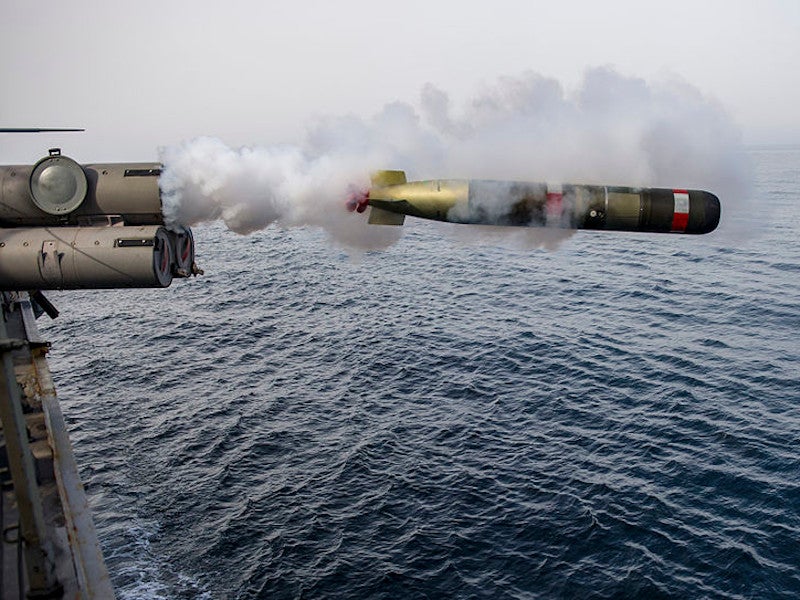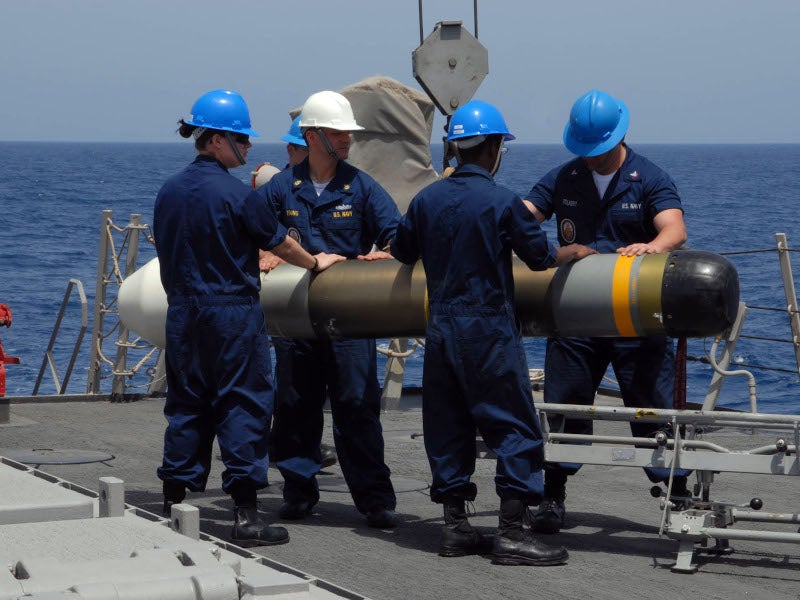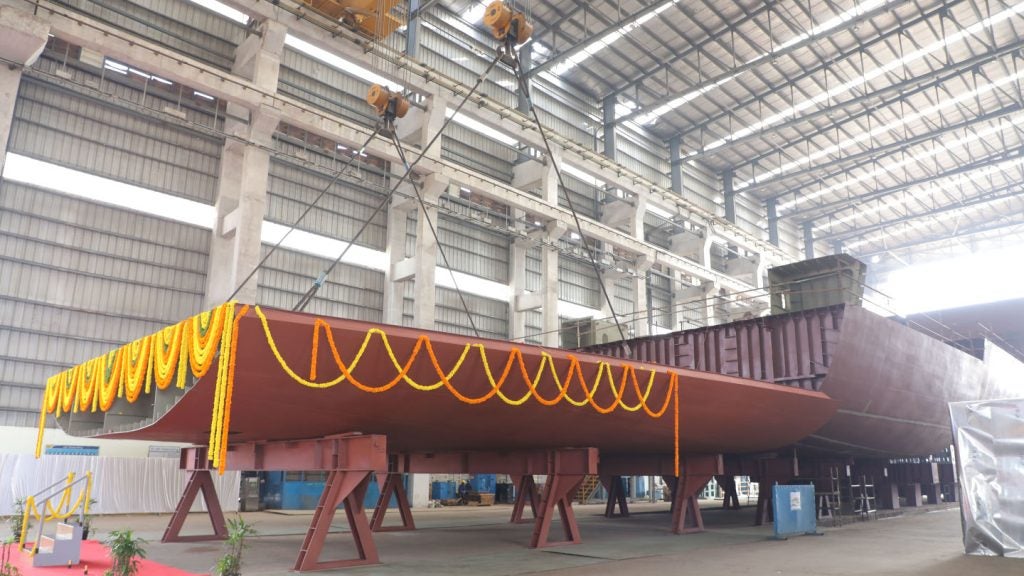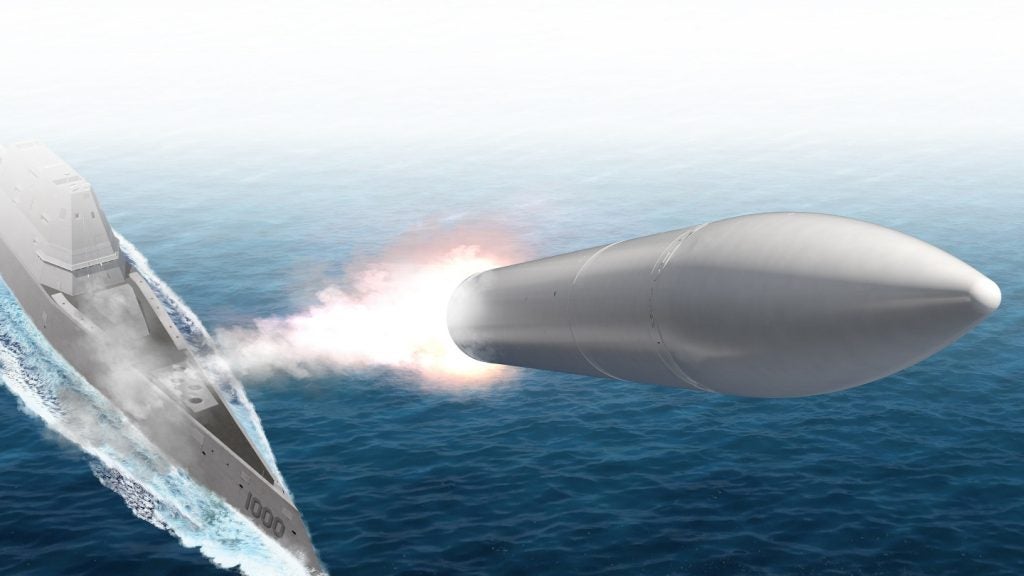MK 54 is an advanced lightweight torpedo designed and developed by Raytheon Integrated Defense Systems in collaboration with the US Navy. It was previously known as Lightweight Hybrid Torpedo (LHT).
The anti-submarine warfare (ASW) torpedo is used in both deep and shallow waters, as well as in acoustic environments. It is capable of tracking, classifying and attacking underwater targets.
Designed for launch from surface ships, fixed-wing aircraft and helicopters, MK 54 replaced the US Navy’s Mark 46 torpedo. The ability to operate in both littoral and deep-water environments enables the torpedo to hit any target irrespective of water depth.
In addition to the US Navy, the torpedo is used by the Indian Navy, Royal Australian Navy, Royal Air Force and Royal Thai Navy.
MK 54 lightweight torpedo development
The US Navy intended to develop an advanced lightweight hybrid torpedo (LHT) for the replacement of its Mark 46 torpedo. A successful critical design review (CDR) was performed in November 1999 after developmental testing began in July 1999. Raytheon won a sole source contract to produce the MK 54 torpedo in April 2003.
The company commenced full-rate production of the torpedo under the Navy’s LHT programme in October 2004. The five-year contract, valued at more than $500m, included the delivery of 51 MK54 lightweight torpedoes and related support services throughout the lifecycle. The torpedo achieved initial operational capability (IOC) in 2004, while the Vertically Launched ASW Rocket (ASROC) (VLA) system attained the IOC in 2010.
The US Navy embarked on upgrading the torpedo and began development of MK 54 Mod 1 torpedo in 2007 followed by in-water developmental testing in November 2015. It continued with the development of MK 54 Mod 1 torpedo sonar section hardware and tactical software in 2017 to overcome previously identified issues. The navy intends to commence operational test and evaluation (OT&E) of the torpedo in the financial year 2020, while IOC is expected in 2023.
With a new propulsion system and warhead, the MK 54 Mod 2 torpedo is expected to be delivered in 2026.
The production of the MK 54 Mod 0 version will cease in the fiscal year 2020.
Design and features of MK 54 lightweight torpedo
The MK 54 lightweight torpedo includes hardware and software features of the Mk 46, Mk 50 and Mk 48 torpedoes coupled with commercial off-the-shelf technology to provide improved ability to tackle shallow-water countermeasures. MK 54 torpedoes are equipped with processing algorithms that help them in detecting false targets or countermeasures and then hunt the identified threats. The torpedo has a length of 2.71m, a diameter of 32.3cm and weight of 275.7kg. The warhead carried by the weapon is high explosive and weighs 43.9kg.
The TG-6000 IMU guidance system is integrated into the torpedo for accurate three-dimensional measurement of motion and acceleration. The active or passive acoustic homing system is fitted to the torpedo for guidance capabilities.
The modernisation of the MK 54 will include upgrades to hardware and software to significantly enhance the probability of kill-and-meet, changing threats in the littoral environment.
Propulsion
The MK 54 lightweight torpedo is powered by a reciprocating external combustion engine, which burns Otto II liquid fuel.
The propulsion system allows the torpedo to cruise at a speed of 74.1km per hour.
Contractors involved in MK 54 lightweight torpedo programme
The US Navy awarded another transaction authority (OTA) contract to Aerojet Rocketdyne for the development of a new propulsion system for the MK 54 Mod 2 in February 2020. The contract will include the development of a prototype stored chemical energy propulsion system (SCEPS) power plant and afterbody / tail cone for integration into the Mod 2 advanced lightweight torpedo (ALWT).
In October 2018, Ultra Electronics secured a $42.1m contract from the US Naval Sea Systems Command (NAVSEA) to manufacture and supply MK54 Mod 0 torpedo array kits and associated spares. The contract also includes the delivery of engineering and hardware repair services.
KVH Industries received the first production order from Raytheon for fibre optic gyro (FOG)-based TG-6000 precision inertial measurement unit (IMU) for use in the guidance system of the MK 54, in October 2003. It was awarded a follow-on order in 2005.
Northrop Grumman received a $45.9m contract from the US Navy in August 2013 to produce MK54 torpedo acoustic nose arrays. The contract value will increase to $294.3m if the US Navy exercises all the options.
Orders and deliveries
The Australian Government placed an order for the procurement of 200 additional MK 54 torpedoes for its navy. The weapon is air-launched from the Royal Australian Navy’s MH-60R ASW helicopters. The Royal Australian Navy placed an $83m order for up to 100 MK 54 all-up-round torpedoes in July 2013.
In August 2016, Raytheon was contracted for supplying torpedo common parts kits to the US Navy and Thailand. The deal also involved the delivery of MK 54 Mod 0 lightweight torpedo kits, MK 54 exercise fuel tanks, spares, and associated support. It had a base value of $37.7m with the total value expected to reach $448.73m if all options are exercised.
Raytheon also won a $29.7m contract modification to produce 100 kits for the US Navy and 68 kits for sale to India, Australia and Turkey for the upgrade of the torpedoes. The US Government cleared the sale of 16 MK 54 all-up-round lightweight torpedoes and three exercise torpedoes to India in April 2020. Estimated to cost $63m, the order also includes spare parts, torpedo containers, two recoverable exercise torpedoes, fleet exercise section, air-launch accessories for fixed-wing and other logistics support services.
The UK Royal Air Force’s (RAF) new P-8A Poseidon maritime patrol aircraft is armed with Mk 54 torpedoes for attacking both surface and sub-surface targets.
Canada’s request for the procurement of 425 torpedo conversion kits was approved by the US Government in May 2019.










